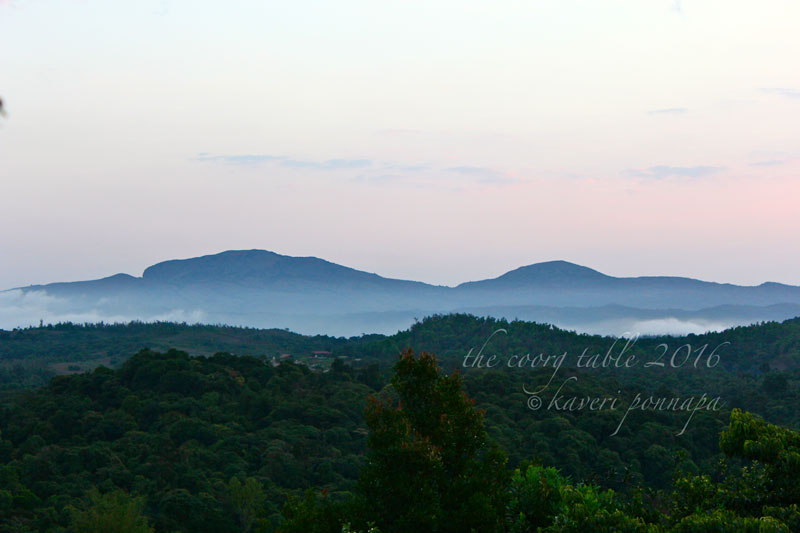In Coorg, the violet hills hide their secrets well. Although meat is an essential part of our cuisine, in forests, on riverbanks, in fields and tangled kitchen gardens lies a wealth of tender vegetables, shoots, and leafy greens that have been regulars on our tables for generations. Foraging and gathering, made fashionable by some of the most famous restaurants in the world are a much-loved part of our food traditions and every season brings the thrill of anticipation, of looking out for special delights from the land through the year. With early summer come round, miniature wild mangoes, to be curried or made into ‘mange mor pajji’ with yogurt; monsoon rains bring spikes of tender bamboo shoot, bimbale, fermented and then curried, salted, fried or pickled. Foraged wild greens refresh monsoon kitchens through this austere season. A little later, everyone scours the countryside for several varieties of prized, earth-scented wild mushrooms that spring up and conversations are all about akki ottis and kumme curry. Winter brings warming beans, squashes and tubers to be stewed and steamed. 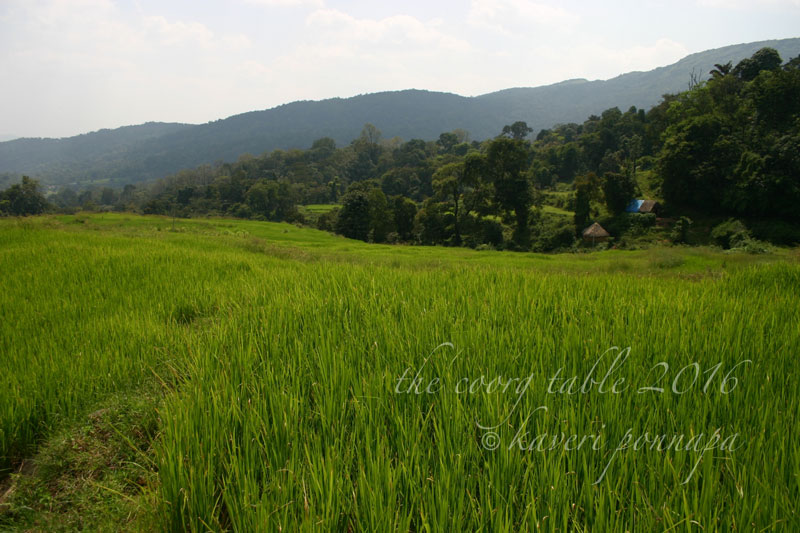 There’s a beautiful serendipity in all this. Most women of my mother-in-law’s generation who lived on coffee plantations never set out on a stroll or a visit to a neighbour without the equivalent of the Russian ‘avoska’, the ‘maybe’ or ‘perhaps’ mesh bag – you never knew what surprise the season would throw your way, a delight to be gathered, taken home and enjoyed: a tender jackfruit, just right for cooking; fresh colocasia leaves on an embankment, ready to be curried; bracken ferns, with their curling tips and herby flavour, perfect for a stir-fry. Perhaps a fistful of sweet rose apples, or a ripe pineapple, quaintly referred to as ‘foreign jackfruit’ to end a meal –or rich, honeyed segments of ripe jackfruit, entirely local.
There’s a beautiful serendipity in all this. Most women of my mother-in-law’s generation who lived on coffee plantations never set out on a stroll or a visit to a neighbour without the equivalent of the Russian ‘avoska’, the ‘maybe’ or ‘perhaps’ mesh bag – you never knew what surprise the season would throw your way, a delight to be gathered, taken home and enjoyed: a tender jackfruit, just right for cooking; fresh colocasia leaves on an embankment, ready to be curried; bracken ferns, with their curling tips and herby flavour, perfect for a stir-fry. Perhaps a fistful of sweet rose apples, or a ripe pineapple, quaintly referred to as ‘foreign jackfruit’ to end a meal –or rich, honeyed segments of ripe jackfruit, entirely local. 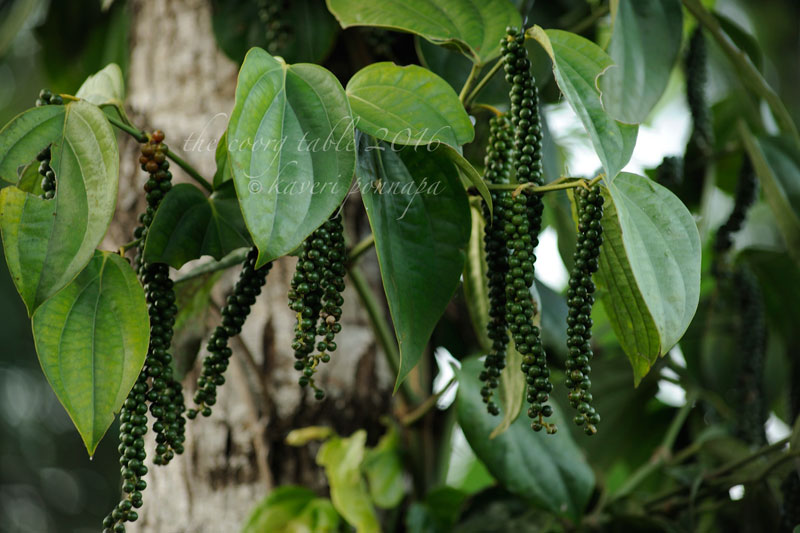 Coorg women are dedicated gardeners and in kitchen plots, ash gourd, ivy gourd, pumpkin and oversized double beans tumble in profusion, to be cooked into mild curries. They are also experts at jam, pickle and wine making. None of the wild fruits and berries scattered across the hillsides escapes their attention, the pleasures of the landscape are plucked, preserved and carefully bottled. Mealtimes are bright with pickles of wild hog-plum –ambatte –sharp tasting local limes and smoky chutneys of charred local bitter oranges. Small wild cape gooseberries, bananas, guavas and mulberries go straight into preserves and jams. The smallest cottage turns out the freshest, most delicious seasonal food.
Coorg women are dedicated gardeners and in kitchen plots, ash gourd, ivy gourd, pumpkin and oversized double beans tumble in profusion, to be cooked into mild curries. They are also experts at jam, pickle and wine making. None of the wild fruits and berries scattered across the hillsides escapes their attention, the pleasures of the landscape are plucked, preserved and carefully bottled. Mealtimes are bright with pickles of wild hog-plum –ambatte –sharp tasting local limes and smoky chutneys of charred local bitter oranges. Small wild cape gooseberries, bananas, guavas and mulberries go straight into preserves and jams. The smallest cottage turns out the freshest, most delicious seasonal food. 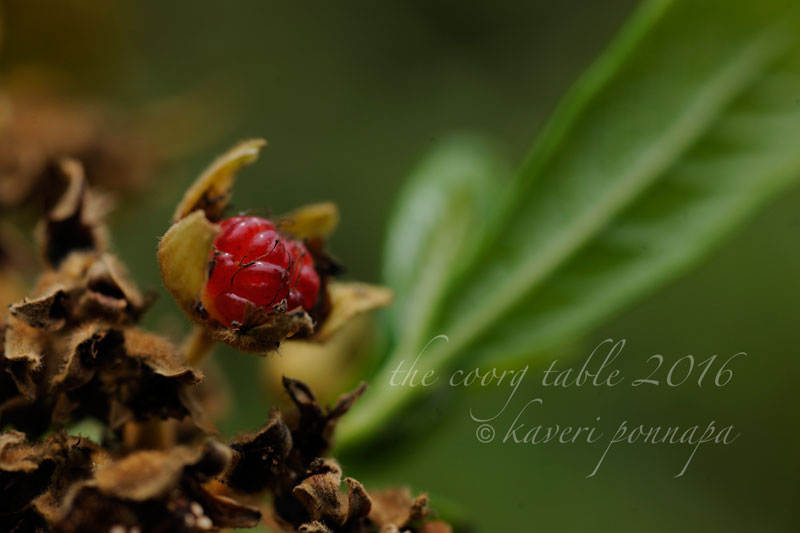
There are distinctive accents at every meal: it might be a chutney of toasted sesame seeds elle pajji, at breakfast, or a lunchtime treat of mudre kanni, a thick, reddish, sour-sweet sauce made from soaked horse gram. Hints of cardamom and pepper that have grown wild on the hillsides for centuries, now cultivated, turn up often and sourness is a tasting note in almost every dish. Kachampuli, the famously tart vinegar is a defining ingredient in both vegetable and meat dishes. Tiny, explosive bird’s eye chillies are prized in pickle making as well as in roasted and barbequed meats.
The green fields supply a treasured grain: there’s rice at every meal. We eat akki ottis, neer dosas or a cluster of soft, steamed puttus, each unique in shape, taste and texture. Rice is also the base for the traditional liquor, kachana kall, a clear, heady saké-like brew. Meals usually end with fresh fruit, or uncomplicated desserts, like jaggrey-sweetened payasas of rice or khas khas, fritters made from local bananas and maybe, halwas and cheeses made from seasonal fruit. Parcels of sweet jackfruit pulp and tari steamed in special leaves, koovale puttus, are a favourite.
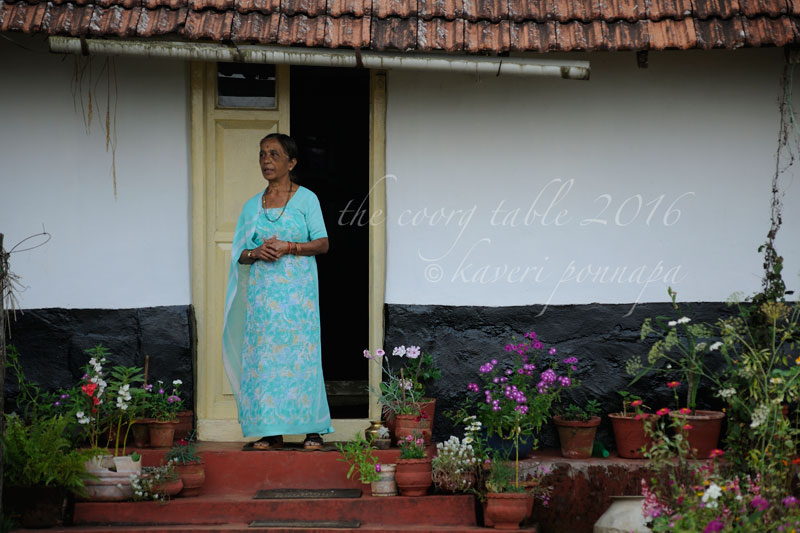 Meals and feasts remain decidedly family and clan-centric –the concept of eating Coorg food at a restaurant has not yet come into being. If you want to explore the landscape on your plate, try eating at a family home. You will always be welcome to share a meal– as we say, there’s always room for one more at the table.
Meals and feasts remain decidedly family and clan-centric –the concept of eating Coorg food at a restaurant has not yet come into being. If you want to explore the landscape on your plate, try eating at a family home. You will always be welcome to share a meal– as we say, there’s always room for one more at the table. 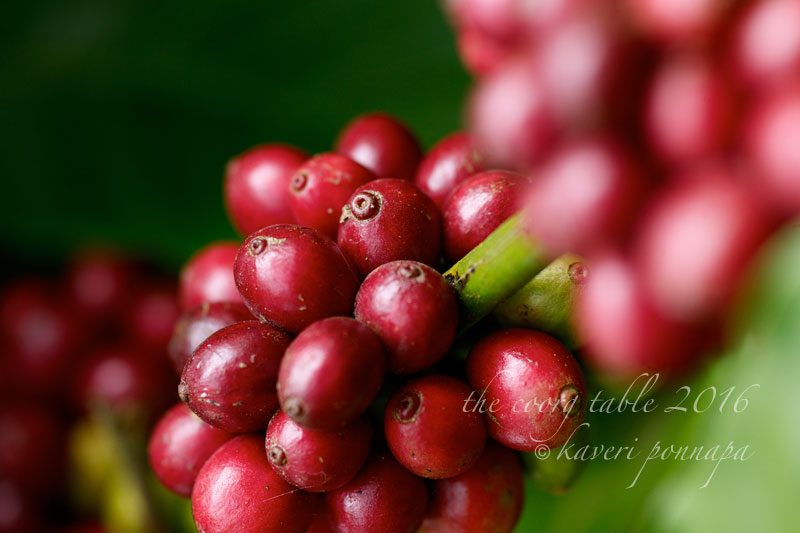
This article appeared in BBC Good Food Magazine, August 2014.
Image Credits: Sudeep Gurtu, K.P.Ponnapa

